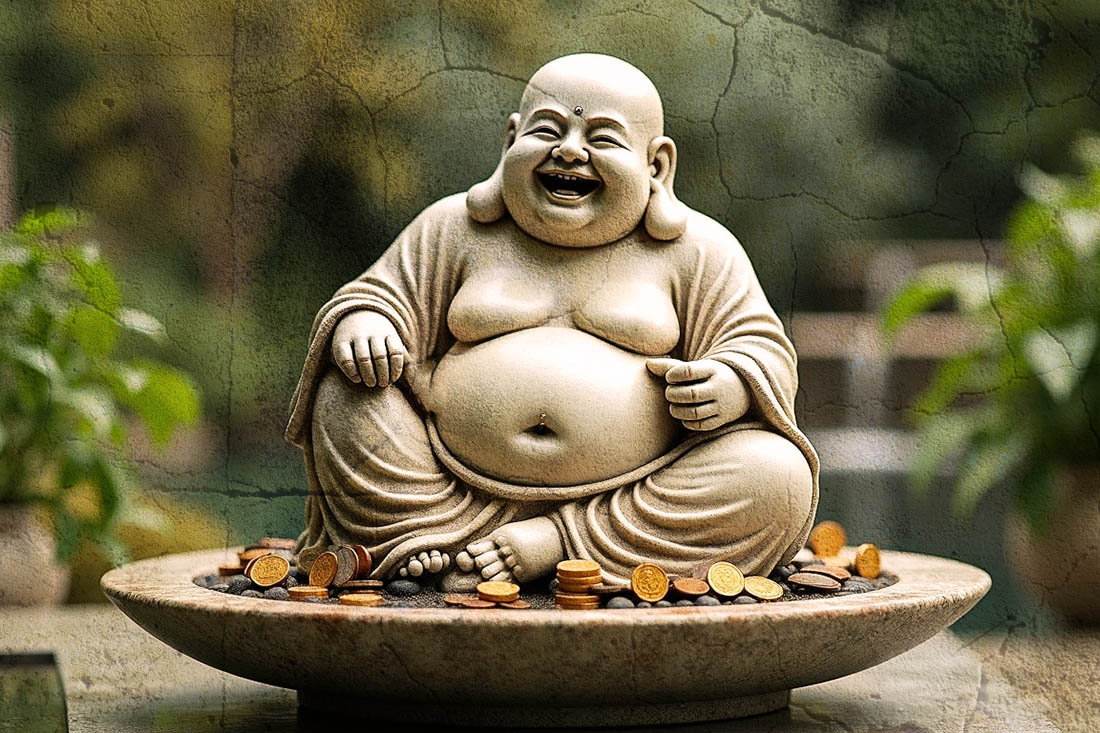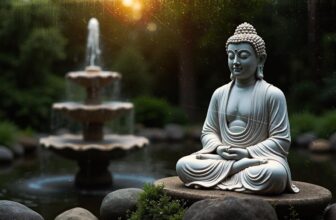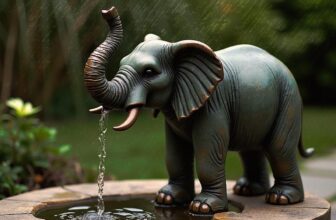
What Does the Laughing Buddha with Coins Sculpture Represent
In homes, offices, gardens, and places of worship across the world, one figure consistently draws attention , a rotund, smiling monk with a belly so big it invites a rub for luck. This jovial figure is none other than the Laughing Buddha, also known as Budai or Hotei, often depicted holding or surrounded by golden coins. But what is the deeper meaning of the Laughing Buddha with coins sculpture, and why has it captivated hearts and imaginations across generations?
Let’s embark on a journey into the fascinating world of this iconic sculpture and uncover its artistic symbolism, spiritual significance, practical placement, and more.
Origins of the Laughing Buddha
Before diving into the specific symbolism of coins, it’s important to understand who the Laughing Buddha is.
The Laughing Buddha is not the same as Siddhartha Gautama, the historical Buddha who founded Buddhism. Instead, the Laughing Buddha is based on a 10th-century Chinese Zen monk named Budai (pronounced “Boo-die”), known for his jolly nature, contentedness, and generosity. In Japanese culture, he is called Hotei and is one of the Seven Lucky Gods of Japan.
He is almost always portrayed as:
Bald and smiling,
With an exposed, round belly (symbolizing wealth and abundance),
Carrying a sack of goodies, food, or wealth,
Sometimes surrounded by children (representing fertility and happiness),
And often, with coins or treasures , the focus of this article.
When the Laughing Buddha is depicted with coins, the symbolism becomes even more powerful and focused on wealth, abundance, and good fortune.
Key Elements:
Gold Coins or Ingots: Traditionally Chinese gold ingots, called sycees, represent wealth and prosperity. Coins can also signify material abundance and financial gain.
The Laughing Buddha’s Smile: His cheerful demeanor indicates joy, optimism, and the ability to stay happy regardless of circumstances.
Overflowing Treasures: The overflowing bag or bowl of coins signals an abundance that is not hoarded, but shared generously.
In essence, the Laughing Buddha with coins represents a life filled with joy, financial success, generosity, and contentment. He embodies the ideal balance between spiritual richness and material well-being.
What Does the Laughing Buddha with Coins Symbolize in Art?
In art, symbols carry layered meanings. The Laughing Buddha with coins sculpture carries a unique visual and emotional impact that resonates across cultures.
Symbolism in Art:
Abundance and Prosperity: Coins are a universal symbol of wealth. The Buddha holding or sitting atop a pile of coins expresses the aspiration for financial abundance.
Happiness Through Giving: Unlike greedy depictions of wealth, the Laughing Buddha is a symbol of generous wealth , the kind that brings happiness to oneself and others.
Overcoming Materialism with Joy: While coins suggest material wealth, the Laughing Buddha’s expression of bliss serves as a reminder that true joy comes not from possession, but from contentment and sharing.
Cultural Fusion: This statue also reflects the blending of religious and folk art, where sacred imagery is infused with everyday wishes like wealth, success, and family happiness.
Color and Form:
Gold is the most common color for these sculptures, representing not only wealth but also divine blessing.
The rounded belly and open posture suggest openness, generosity, and a welcoming spirit , all qualities essential to harmonious living.
What is the Meaning of the Laughing Buddha with Coins Sculpture?
At its core, the Laughing Buddha with coins sculpture encapsulates a philosophy of happiness and abundance.
Spiritual Meaning:
Encourages you to approach life with a light heart.
Suggests that wealth, when coupled with a generous spirit, brings lasting joy.
Offers spiritual protection and removes negative energies associated with poverty and scarcity mindsets.
Cultural Meaning:
In Feng Shui, the sculpture is considered a powerful cure for financial troubles and an attractor of wealth.
In Chinese traditions, it is believed to bring in luck, especially when placed in the wealth corner of your home or office.
Whether you’re a spiritual seeker or an art lover, the meaning remains rich: Live joyfully, share abundantly, and welcome prosperity with humility.
Is Giving a Laughing Buddha a Good or Bad Idea?
Giving someone a Laughing Buddha sculpture , especially one with coins , is widely seen as a positive gesture with deep-rooted significance.
Reasons Why Giving It Is Good:
Symbol of Blessings: It symbolizes a wish for the recipient’s happiness, prosperity, and success.
Cultural Tradition: In many Asian cultures, giving such a statue is an act of goodwill and friendship.
Conversation Piece: It becomes a memorable, artistic gift that can brighten any room.
Positive Energy: It’s believed to bring good vibes and ward off misfortune, making it a thoughtful housewarming or business gift.
Best Occasions to Gift:
Housewarmings
New business ventures
Weddings
Birthdays (especially milestone ones)
Retirement or promotion celebrations
Important Note: According to tradition, you should not buy a Laughing Buddha for yourself , it should be gifted to you. This belief suggests that the energy of the statue is more powerful when received with love.
Is the Laughing Buddha with Coins Statue Good for Garden Sculptures?
Absolutely , the Laughing Buddha makes an excellent garden sculpture, and when adorned with coins, it adds a playful yet powerful touch of abundance to outdoor spaces.
Benefits of a Garden Laughing Buddha:
Welcoming Presence: His cheerful face and relaxed pose create a warm, inviting atmosphere.
Natural Harmony: Gardens symbolize growth, peace, and life. Placing a statue of prosperity in this setting amplifies natural abundance.
Feng Shui in Nature: According to Feng Shui, the east part of your garden is ideal for spiritual or health-related statues, while the southeast is best for wealth. A Laughing Buddha with coins in the southeast corner enhances financial flow and well-being.
Tips for Placement:
Place the statue where it’s visible, clean, and elevated slightly above the ground.
Ensure it’s not directly facing trash bins or clutter, as this is considered disrespectful.
Ideally, the statue should be protected from heavy rains and dirt to maintain its cheerful appearance.
Does the Laughing Buddha with Coins Sculpture Bring Good Luck?
Yes, the Laughing Buddha with coins is strongly associated with good luck in multiple traditions.
How Does It Bring Luck?
Activates Wealth Energy: In Feng Shui, it enhances the chi (energy) of prosperity, attracting opportunities and windfalls.
Promotes Positive Vibes: Its joyful appearance lifts moods, reduces stress, and fosters harmony.
Clears Obstacles: Believed to remove financial blockages and usher in smoother, more successful endeavors.
For best results, place the sculpture in one of the following places:
Entrance Hall or Foyer: Facing the main door, it invites wealth and good vibes into the home.
Living Room: To promote joy, health, and abundance for the family.
Office or Business Space: Near a cash register or work desk to attract financial success.
Where Not to Keep the Laughing Buddha with Coins Sculpture
Although it’s a powerful symbol, placement matters greatly when it comes to spiritual and Feng Shui artifacts. Here are places to avoid:
Places to Avoid:
Floor or Bathroom: These are considered impure places and disrespectful to sacred images.
Bedroom: Since the Laughing Buddha is a high-energy figure, it can disrupt sleep and relaxation.
Kitchen: Another inappropriate area due to the nature of cooking and food waste.
Hidden or Low Places: Never place it under shelves, inside drawers, or behind other items.
Directly Facing Stairs: Especially if the stairs go downwards , this may be seen as draining prosperity.
General Rule:
Keep the statue in a clean, respectful, and prominent space, preferably at eye level or above, and facing into the room or toward an entrance.
A Symbol of Joy That Transcends Wealth
The Laughing Buddha with coins sculpture is far more than a cheerful decoration. It represents an ancient and profound fusion of joy, abundance, generosity, and spiritual richness. Whether placed in a garden, gifted to a friend, or installed in your business, it brings with it centuries of symbolism and positive energy.
In a world often caught up in the pursuit of wealth, the Laughing Buddha reminds us that true prosperity lies in a joyful heart, an open hand, and a peaceful spirit. His belly may symbolize wealth, but his smile symbolizes the kind of happiness that money can’t buy , a happiness rooted in gratitude, laughter, and shared abundance.
So whether you’re considering gifting one, decorating your garden, or inviting more joy into your space, the Laughing Buddha with coins is a timeless companion on the journey to a life of meaningful abundance.




